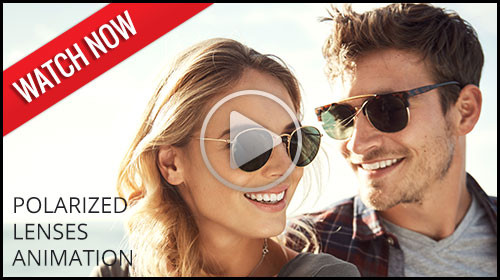| Anti-Reflective Coating | Bifocal Lenses |
| Cosmetic & Specialty Tints | High Index Lenses |
| Progressive Lenses | Photochromics |
| Polarized Lenses | Scratch Resistant Coating |
| Digital Lenses |
Anti-Reflective Coating
Normal lenses often create glare, reflections, and "ghost images." Now that can be eliminated with an anti-reflective coating.
What we see is a result of light being sensed by our eyes. With normal glasses, much of the light reflects off the lenses. This produces glare. It also reduces the wearer's visual acuity. In other words, the light reflections are a visual and cosmetic problem.
Anti-reflective coatings increase light transmission through the lenses to 99.5 percent. They make it easier to see and easier for others to see you. These coatings are especially useful for those viewing computer screens, working under fluorescent lighting, and driving at night.
Bifocal Lenses
For many people, different lenses are needed for seeing at different distances. Bifocal lenses allow the wearer to look through two areas of the lens. One area focuses on distant objects. The other is used for reading. In fact, bifocals were invented by Benjamin Franklin, and his style of bifocals are still available today. Most of the time the “reading” area is smaller, shaped like a sideways “D”, and found in the lower hemisphere of the lens. These bifocals are called line bifocals or flat-tops. If you are focusing on distant objects, you look through the top half of the lenses. To read a book, magazine, or newspaper, you look through the “reading” area. One thing that is difficult about using bifocals is dealing with the line between the two vision areas. It is difficult to switch from one focusing power to another. It can make your eyes tired, and it can even lead to a headache, sore neck and sore back.
Progressive Lenses
Progressive lenses provide a smooth transition from focusing nearby to focusing on distant objects - without a line! Instead, a gradual change in power allows the wearer to focus on objects at all distances. Distant objects are viewed through the upper portion of the lens, while near objects are viewed through the middle or lower portion of the lens. These are also great for computer users.
Cosmetic Specialty Tints
Tints are available in a variety of colors and shades. Set yourself apart by choosing a tint that appeals to you or select from one of our many "functional" tints. Yellow is great for night driving and snowy conditions while green is favored by many pilots. Let the ladies at Image Optical tell you about the many benefits of different lens colors.
High Index Lenses
Previous to the last few years, the only materials available for use as lenses were glass and a hard resin called CR-39. But recently, high index lenses have become available. High index materials are named because they have a higher index of light refraction. Basically, they can do the same job that glass or CR-39 does, but high index lenses are much thinner and lighter. With high index lenses, you can avoid having “soda bottle” lenses. When learning about high index lenses, you may hear many unfamiliar numbers and terms. Here are a few things to remember.
Polycarbonate
The first and still the most popular high index plastic is polycarbonate. Polycarbonate was originally developed for fighter jet cockpits. It is very strong, very light, and resistant to scratches and breaking. Most sports lenses are made of polycarbonate.
Mid-Index
Other high index materials are classified by numbers. The higher the number, the thinner and lighter the lens. The lower numbers are classified as mid-index lenses. Mid-index lenses, such as 1.54, 1.56, and 1.57, are thinner than glass, and nearly as strong as CR-39.
High-Index
High index lenses, typically ranging from 1.53 to 1.74such as 1.66, 1.74, and 1.9, are much thinner than regular glass or plastic. Talk with your doctor to decide which high index lens is right for you.
Photochromics (Transitions Lenses)
If you have ever felt frustrated at needing both prescription glasses and prescription sunglasses to accommodate an outdoor lifestyle, you should consider photochromic lenses. Photochromic lenses darken when exposed to UV rays. The change is caused by photochromic molecules that are found throughout the lens or in a coating on the front of the lens. When the wearer goes outside, the lenses darken or tint. When the wearer goes back inside, the glasses become clear.
There are a variety of photochromic options available. Depending on what you choose, you can customize the lenses to your needs. Some lenses darken only in direct sunlight, while others darken in little or no direct light. Some are designed to darken while you are in the car to reduce road glare while you are driving. You can even choose the color of the tint. Ask your doctor what options are available.
Polarized Lenses
Glare from wet roads, light reflecting off other vehicles, and glare from your own windshield can be annoying and dangerous. To eliminate this glare, we offer polarized lenses. Polarized lenses eliminate almost all glare, reducing eye strain and increasing visibility. Polarized lenses are the most effective way to reduce glare.
Most glare comes from horizontal surfaces, so the light is “horizontally polarized.” Polarized lenses feature vertically-oriented “polarizers.” These polarizers block the horizontally-polarized light. The result is a glare-reduced view of the world. Polarized lenses can make a world of difference for any outdoor enthusiast. Fisherman can eliminate the bright reflections from the water and actually see into the water more easily than with other sunglasses, golfers can see the green more easily, and joggers and bikers can enjoy reduced glare from the road. In addition, drivers can enjoy the safety and comfort that polarized lenses provide while driving.
Scratch Resistant Coating
Today's standard lenses include a scratch resistant coating. This coating drastically reduces the amount of scratching from normal, everyday wear.
Digital Lenses
Lens manufacturers are producing new digital lenses specifically designed for your lifestyle. From golfing to computer gaming, we can find a lens designed with you in mind. Recently CVS (computer vision syndrome) has become increasingly problematic for those of us who use computers daily. CVS is characterized by headaches, eye strain, neck and back aches, dry eyes, blurred vision, and double vision. We can recommend a computer, or occupational lens designed to be worn in the office or at home to reduce CVS strain and give you more comfort on your computer.









